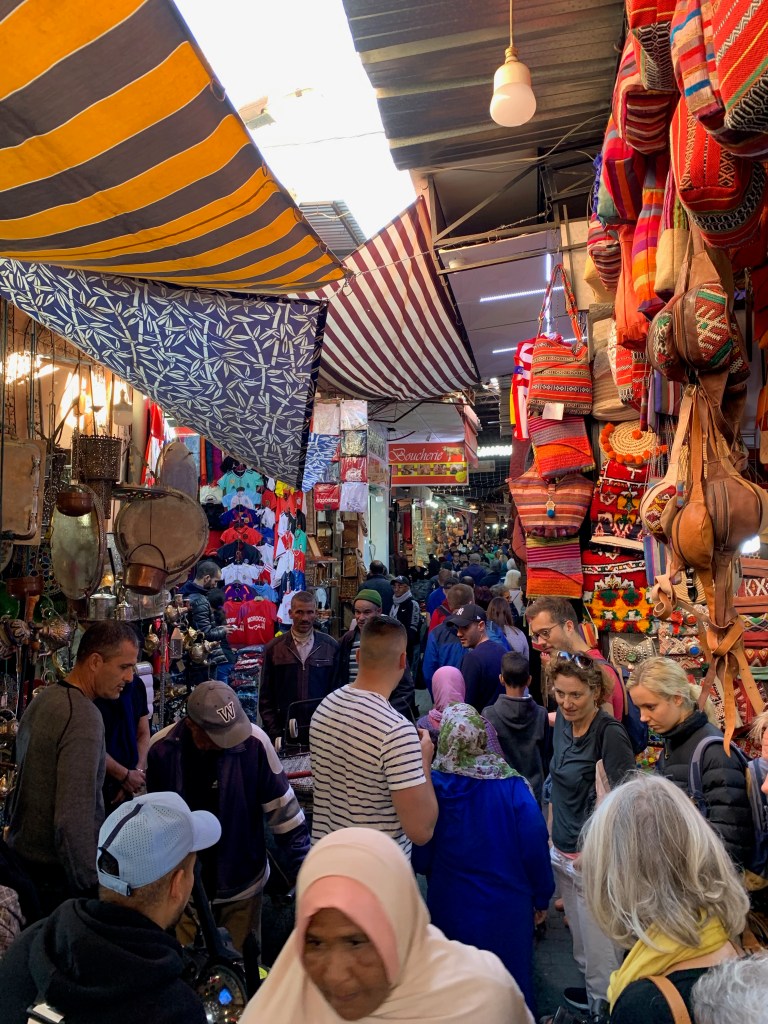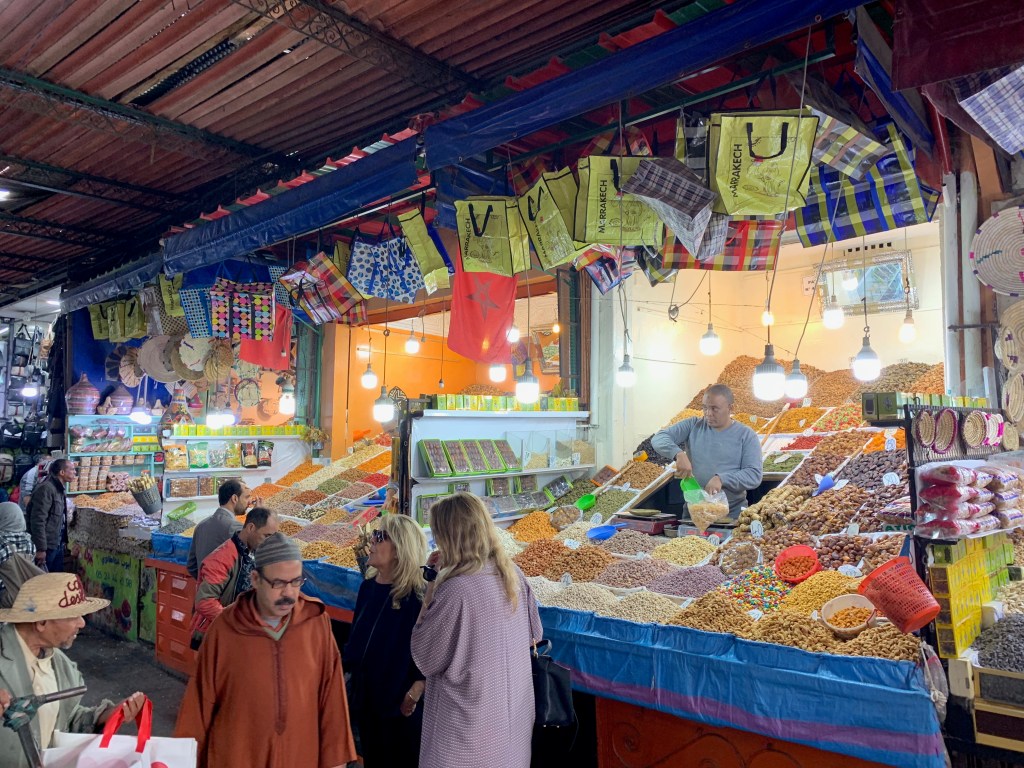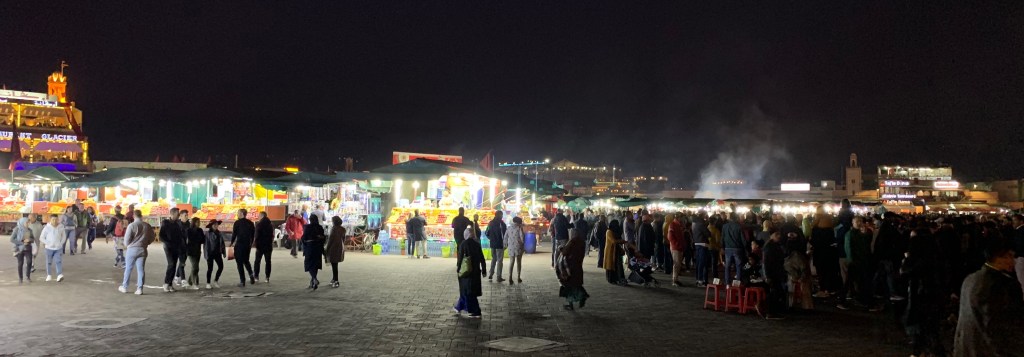The medina in Fes felt like a time warp. Men in traditional hooded robes called djellabas walk up and down the narrow, twisty streets. Merchants sell food, pottery, leather, and metal crafts as they have for a thousand years. There are relatively few tourists. The pace of life seems unhurried.
The Marrakesh medina is a sharp contrast. There are far more tourists in Marrakesh. We’ve seen all sorts including university students on vacation, backpackers, huge tour groups following their leader’s upraised flag, and well-dressed couples who don’t like the pervasive sewage smell and look a little anxious about stepping in whatever that is on the ground over there.
The streets and alleys of the medina in Marrakesh are somewhat wider than in Fes, and – crucially – they are no stairs (Fes is shaped like a giant bowl). As a result, they’ve become infested by young men (and occasionally women) on motor scooters. These scooters (feeling like full motorcycles at times) race up and down the streets, their tiny engines angrily buzzing like giant mosquitos. Pedestrians in Morocco are expected to watch out for themselves, and the medinas are no exception. This is sometimes easier said than done, since the streets are packed with tourists, locals, and wares for sale. The frenzy reminded us of scenes from Raiders of the Lost Ark. While we avoided incidents, the scooters brought an unwelcome bit of stress to our time in Marrakesh.
Our riad, on the other hand, was an oasis. A riad is a traditional Moroccan house that is built around a central courtyard large enough to house a fruit tree or small garden. Our riad, like many, has been converted into a small guesthouse. Situated at the end of a narrow alley that branches off another narrow alley, it was almost completely nondescript from the outside. Inside, the whitewashed walls and tasteful decoration were relaxing – a break from the visual chaos of the medina. Our room was on the second floor, just past a lovely open mezzanine where we’d sit to read, do schoolwork, or (ahem) watch videos of other people playing Minecraft. A roof deck offered sun loungers and a plunge pool. Several cats hung out on the roof. It wasn’t clear whether the cats belonged to our riad, one of the adjoining buildings, or only to themselves.


Since we’d already had several days in the Fes medina, we didn’t feel like we got a lot out of the additional motorbike-addled chaos of Marrakesh’s medina. The boys were certainly done with the medina by this point too, and were fairly vocal about it. Despite this we found some interesting things during our wanderings (aided by our guidebook and Apple Maps. Unlike Fes, Google Maps makes no attempt to map this medina beyond the largest streets).
The photography museum holds prints of Morocco from the 20th century, giving a glimpse of life in the country before cars and cell phones (and scooters).
The Museum of Women – first of its kind in Africa – tells the story of several different women in Morocco. I was struck by the story of Malika al-Fassi, a writer and advocate whose life was far more compelling than her Wikipedia entry suggests. She was the only woman to sign Morocco’s Declaration of Independence, and she cleverly leveraged the patriarchal culture to successfully promote improved education for girls and young women.
The Dar Si Said is home to the National Museum of Weaving and Carpets. There were some interesting exhibits (such as the carpets woven out of thin strips of leather) but the main draw for us was the architecture. The museum is housed in a restored riad with stunning ornamentation and a large, peaceful courtyard.
The Medersa Ben Youssef is one of Marrakesh’s top attractions. A center of Islamic learning dating back hundreds of years, it is closed for extensive renovation. We missed this and some of the other “must do” sites. Ironically on a trip this long we can’t see everything – we need to keep a slower, more-sustainable pace.






At the south end of the medina is the huge square of Jemaa el-Fnaa. The square is a focal point for the medina. Surrounded by tourist restaurants and hotels, there is always something going on here. Vendors hawk their wares and polyglot restauranteurs invite dining in a dozen different languages. Rows of juice vendors, their stalls piled high with fresh fruit, invite you to take refreshment. One vendor wears a tuxedo. Snake charmers invite you to take photos (for a fee of course) of their drugged-up, indifferent cobras. A man with a small monkey invites you to “borrow” it for more pictures. In your left ear the flute of the snake charmer; in your right a local band is warming up with amplified guitars. All around there are sights, sounds, and smells to process.
At nighttime, the energy of the square becomes frantic. The crowd is bigger and moves faster. Belly dancers and more bands take the place of the women offering henna tattoos. Any one of them would be fine to listen to, but in such close proximity we listen to all of them at once. The famed story-tellers of the square are setting up their small semicircles of stools. I have no idea how anyone will hear them over the din. The restaurant sales pitches are more aggressive. Pretending not to understand a pitch given in French or English only results in an attempt in Spanish or German. “Maybe later” is the only response that works. Some people are pitched to in Arabic; never us. The touts selling t-shirts insist that you buy one, or two. This shirt is very nice. The tout likes our family and will give us a good price. The man selling light-up trinkets makes a beeline for the boys, attempting to hook them on his shiny gizmos. The man selling sunglasses does not seem to notice it’s nighttime; the sharp Moroccan sun replaced by a moon happy to be far removed from the chaos down here. Everywhere we turn there is more: more noise, more people, more sights, more movement, more smells. The energy in the frenetic square continues to build as people flow in from the surrounding alleyways.
We can’t stay here long. Our senses are overloaded and the boys are hungry. Our brains are so busy trying to shut out the din that we can’t think. Can’t answer simple questions like “does this restaurant look ok?” We make our escape down a familiar street and a few minutes later enter a restaurant near our riad. The dining room is upstairs. It is completely empty. Silent. The proprietor is an older gentleman delighted to see kids. He brings us bread, and with a grin tells Nate that he is responsible for the bill tonight.

2 replies on “In Marrakesh”
What a wonderful description of a fabulous experience! Thanks for sharing this!
LikeLike
Whew!
LikeLike